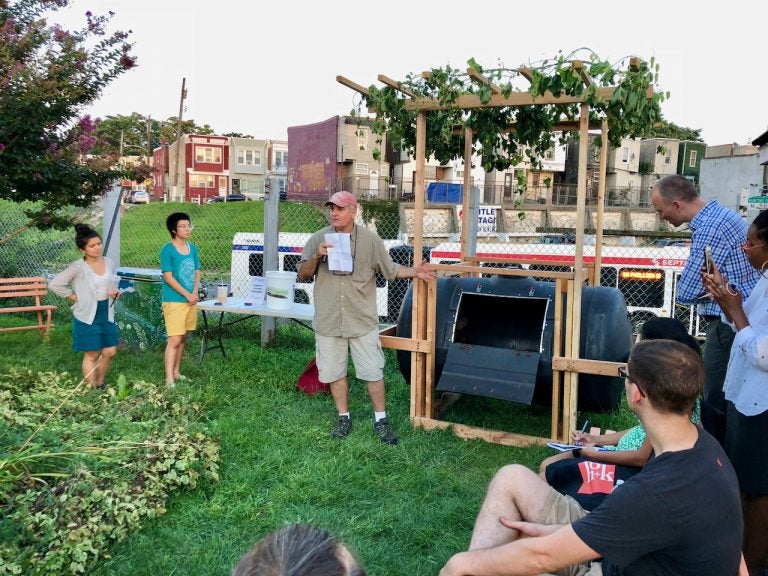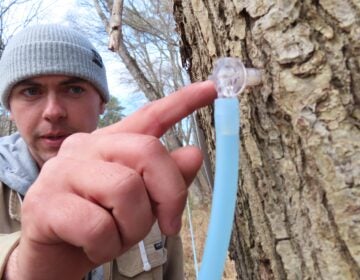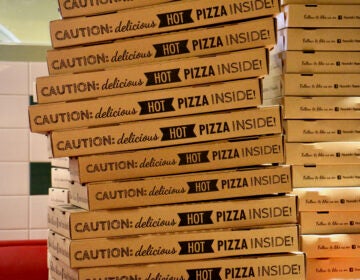To vanquish food waste, a competition aims to design and compost
A competition to invent a new, better bin was launched last year by the Philadelphia Food Policy Advisory Council, which is overseen by the Mayor’s Office of Sustainability

Tony Guido explains features of a composting vessel he helped build for a Philadelphia Food Policy Advisory Council design competition. (Meir Rinde/PlanPhilly)
This story originally appeared on PlanPhilly.
—
To the uninitiated, it sounds simple enough: Design a cheap, urban-friendly composting device that works at a neighborhood scale — something bigger than a backyard composting bin, but smaller than a commercial system that costs thousands of dollars to build.
Making that happen, however, turned out be more challenging than the project’s sponsors may have anticipated.
A competition to invent a new, better bin was launched last year by the Philadelphia Food Policy Advisory Council, which is overseen by the Mayor’s Office of Sustainability. FPAC asked entrants to come up with an enclosure that cost less than $500 to build, could take up to 500 pounds of food waste a week, and was rodent-proof, weather-proof, and easy to load and unload, among other requirements. The winner would receive a $500 prize.
The goal was to offer a convenient option for getting rid of food waste and yard trimmings, so residents could help the city hit its target of reducing landfill and incinerator disposal 90 percent by 2035.
The contest started off promisingly, with 20 conceptual submissions received, FPAC manager Hannah Chatterjee said. Those were narrowed down to two that FPAC asked the competitors to build.
On Wednesday, the council showed off the resulting prototypes and revealed that the winner was… neither.
“We have a little bit of a surprise for you, and it is that we don’t have a final winner today. What we do have are two runner-ups,” Chatterjee told those attending the unveiling at Share Food Program on West Hunting Park Avenue. “There are flaws with both of them.”
That doesn’t mean the city has given up on neighborhood composting or the pursuit of a better bin. Chatterjee said FPAC is still launching a mini-grant program to fund three $400 awards to organizations, schools, gardens and other groups that want to create composting facilities. They will use traditional three-bin systems, which are inexpensive but take a fair amount of space and are open to the elements.
Nic Esposito, the city’s zero waste and litter director, said the contest was worth pursuing, in part because of the lessons learned about bin design and what will work for Philadelphia neighborhoods.
“We wanted to see: How can we do something that’s a little bit more in-vessel, that takes care of some of those problems you have in a more urban environment?” Esposito said. “It’s great to do something on urban farms and gardens, but what if you have a neighborhood that doesn’t have a farm or garden? If we could do something like that, that’s maybe on a school site or a rec center, we can meet our pledge of equity.”
Despite the lack of a winner, Esposito and FPAC staffers said the designers did good work and praised them, particularly industrial designer Tony Guido, for turning concepts into usable, if imperfect, products.
One of the two finalist bins, developed by Canadian composter Bert Baillie and built by the organization Let’s Talk Trash in British Columbia, consisted of a standalone chest freezer fitted with a cedar grate and pipes to exhaust gas and drain liquids. It’s sturdy, relatively small, and has a locking lid that keeps out Canadian bears as well as smaller critters attracted to food waste, FPAC staffers said.
Baillie reclaims old freezers from a trash dump, has an appliance store remove the coolant for free, and customizes the units himself, spending about $50 on materials for each one. But the freezer’s tight lid limits its usefulness, Chatterjee said.
“It’s actually so enclosed, it doesn’t aerate enough, so the product you get is similar to what you get in an anaerobic-digestion scenario,” she said. “You can dry it out and use it for fertilizer, but the end product’s not really something a community gardener would use.”
Anaerobic composting doesn’t use oxygen, takes longer, and can be smelly.
Also a finalist was a black cylindrical water tank surrounded by a wooden frame and resting on casters so it can roll in place, which aerates the compost and speeds decomposition. In the initial design, created by a student at the Workshop School, a stationary cyclist powered a battery and an electronic system controlled the cylinder via gears and a chain.
When the student didn’t have time to complete the project, Guido stepped in and redesigned it to make it simpler and cheaper, and to ensure that it was safe to use. An associate professor at the University of the Arts, Guido said compost only needs to be turned about once a week, so he dropped the bike and gears in favor of handles that let users manually push the 330-gallon tank.
In consultation with Bennett Compost, the Philadelphia company whose owners evaluated the bin designs, Guido decided the system would require active management rather than operating somewhat automatically.
“Over time, we came to this idea that perhaps it should be very easy to put together and accessible; if it breaks, it should be easy to fix it; and we should welcome people to composting. It should be something where it’s a center, where people can come and meet,” he said. “The main idea is that composting takes knowledge and takes people to care for it and kind of nurture this compost along.”
The cost was on the high side, at $250 for the tank and $250 to ship it from the manufacturer in Minnesota, plus additional materials and labor, although that could drop if the design is adopted and used in multiple locations, Guido said. A bigger problem, Chatterjee said, is the unwieldiness of the tank when it contains enough food waste to achieve the critical mass at which decomposition occurs.
“When it does get full, it’s almost impossible for two grown people to turn it. Practically, it’s going to be difficult to fill this to its full capacity and get it hot enough,” he said. “But it’s potentially good for lighter waste, like yard waste.”
Guido and Bennett Compost may continue improving the composter if new funding for materials becomes available. Esposito said future design efforts will incorporate their understanding of how a neighborhood compost site needs to operate.
“We’ve realized, with this competition, that we’re not just going to have some magical design that you can just throw a bunch of food in, walk away, come back a month later, and everything’s going to be this beautiful compost,” he said. “It’s going to take community to do this, but we want community to be involved.”
He noted that City Hall also is promoting ways of diverting waste that could make a much bigger dent in demand for traditional trash disposal, such as large-scale anaerobic-digestion centers that could process “massive mounts” of materials from grocery stores and restaurants. The city already composts food waste from large events like the Broad Street Run and the Philadelphia Marathon at the Fairmount Park Recycling Center.
Last year, Philadelphia reportedly diverted about 21 percent of the 623,474 tons of waste it collects annually, or 38 percent if private collection is included. A 2010 study found that an estimated 12 percent of the city’s garbage is leaf and yard waste and 13 percent is food and other organics.
City officials have held off on initiating separate collection of residential organics because there is no composting facility in Philadelphia that can accept tons of waste.
WHYY is your source for fact-based, in-depth journalism and information. As a nonprofit organization, we rely on financial support from readers like you. Please give today.







